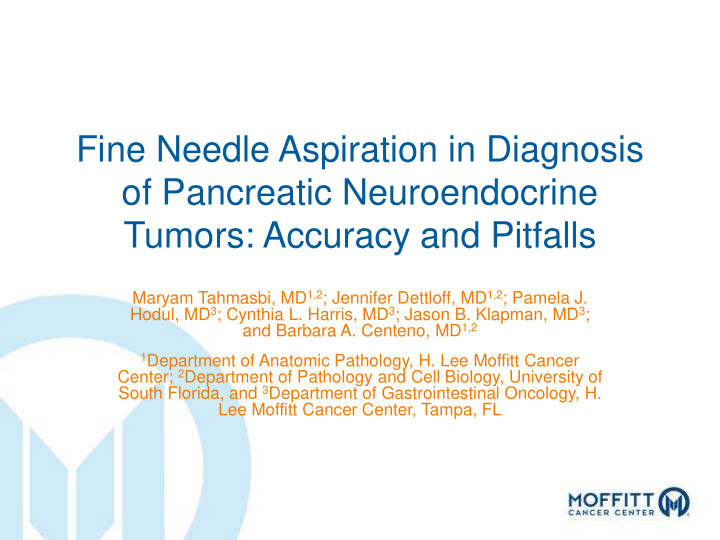



Fine Needle Aspiration in Diagnosis of Pancreatic Neuroendocrine Tumors: Accuracy and Pitfalls Maryam Tahmasbi, MD 1,2 ; Jennifer Dettloff, MD 1,2 ; Pamela J. Hodul, MD 3 ; Cynthia L. Harris, MD 3 ; Jason B. Klapman, MD 3 ; and Barbara A. Centeno, MD 1,2 1 Department of Anatomic Pathology, H. Lee Moffitt Cancer Center; 2 Department of Pathology and Cell Biology, University of South Florida, and 3 Department of Gastrointestinal Oncology, H. Lee Moffitt Cancer Center, Tampa, FL
Introduction • Pancreatic neuroendocrine tumors (PanNET) are rare, but are increasingly being discovered, and sampled by fine needle aspiration (FNA). • Here we evaluate our experience with FNA to assess its accuracy for the diagnosis of PanNET, and to identify pitfalls.
Materials and Methods • This is a retrospective study. • The anatomic pathology LIS was searched using an IRB approved protocol, from October 2008 to December 2014, to identify patients who had been diagnosed with PanNET on either FNA or subsequent surgical resection (SP). • A total of fifty-six patients were identified who met these inclusion criteria. • The WHO 2010 system was used for classification in this study.
Results • Fifty-three (94.6%) patients had a diagnosis of PanNET on SP: – 50 well-differentiated (WD) – 3 poorly differentiated neuroendocrine carcinomas (PDNEC) • Three (5.3%) patients had samples diagnosed as PanNET on FNA that were other neoplasms on SP: – 1 paraganglioma (Fig. 3A-3C) – 1 solid pseudopapillary neoplasm (SPN) (Fig. 4A-C) – 1 adenosquamous carcinoma
Results-Cont’s From those 53 patients with samples diagnosed as PanNET on SP: • Thirty-nine (74%) were accurately diagnosed by FNA, and all of them were WD PanNET. • Eight (15%) were diagnosed as adenocarcinoma/suspicious for adenocarcinoma on FNA; which on SP: – 3 PD NEC (Fig. 1A-1C) – 5 WD PanNET (Fig. 2A-2C) • Three cases were unsatisfactory and three cases were atypical (overall 11%) due to scant representative cells.
39 (74%) cases were accurately diagnosed by FNA 8 (15%) cases were diagnosed as 53 (94.6%) cases on SP adenocarcinoma/susp for adenocarcinoma on FNA 56 patients had been 6 (11%) cases were diagnosed with PanNET unsatisfactory (3) or (10/2008-12/2014) atypical (3) on FNA Were other neoplasms on SP (1 SPN, 1 3 (5.3%) cases on FNA paraganglioma, and 1 adenosquamous carcinoma)
A B C Case 1. PD NEC diagnosed as adenocarcinoma. A. The smears show clusters with malignant nuclear features (Pap, 60X). B. The cells show some molding and rounded nuclei, with pale chromatin and small nucleoli. The cytoplasm is scant and there is crush artifact (Pap, 60X). C. The resection showed a poorly differentiated neuroendocrine carcinoma (H&E, 20X). The synaptophysin was positive (inset). Synaptophysin,20X
A B C Case 2. PanNET diagnosed as suspicious for carcinoma. A. The smear contains duodenal contaminant and an adjacent group with nuclear overlapping, crowding, and irregular nuclear membranes (DQ, 60X). B. The alcohol fixed smear shows a group with nuclear overlapping and crowding. The cells have a high N/C with chromatin clearing (PAP, 60X). C. The resection showed a PanNET with oncocytic cytoplasm (H&E, 20X).
A B C Case 3. Paraganglioma diagnosed as endocrine neoplasm. A. The cells are arranged in a loose cluster, and have bubbly cytoplasm (DQ, 60X). B. The nuclei are rounded with salt and pepper chromatin. Stripped nuclei are also present (PAP, 60X). The IHC performed on this case (not shown), demonstrated expression of synaptophysin. Cytokeratin was negative. C. The resection showed a paraganglioma (H&E, 20X).
A B C Case 4. SPN diagnosed as PanNET. A. The cells are arranged in loose clusters of cells with bubbly cytoplasm, and pink intracytoplasmic globules (DQ,60X). B. The nuclei are rounded, monomorphic, with finely stippled chromatin (PAP, 60X). C. The resection showed the classic histomorphology of SPN. The cells have cytoplasmic vacuoles and inclusions. Noted are capillaries surrounded by a mucinous stroma (H&E, 40x).
Conclusion • FNA can accurately diagnose PanNET. • Pitfalls were due to: – Morphological overlap with some neoplasms – Under-recognition of neuroendocrine features – Scant representative cells • A definitive diagnosis should be based on well-preserved morphology and ancillary studies.
Acknowledgements Special thanks to: • Barbara A. Centeno, MD • Jennifer Dettloff, MD
THANK YOU
Recommend
More recommend